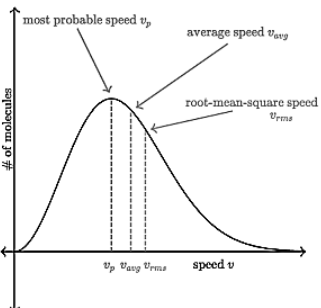
For gaseous state, if most probable speed is denoted by
a-
b-
c-
d-
Answer
486.9k+ views
1 likes
Hint: The given three representations of velocity are related to each other by following formula:
Complete answer:
Kinetic Molecular Theory explains the macroscopic properties of gases and can be used to calculate the different kinds of gaseous speeds. Measuring the velocities of particles at a given time results in a large distribution of values; some particles may move very slowly, others very quickly, and because they are constantly moving in different directions, the velocity could equal zero.
-Most probable speed (
C*=
-Average speed (
-Root mean square speed (C or
C or
On comparing these three velocities:
=
=1 : 1.128 : 1.225
So, the correct option is (B) 1: 1.128: 1.225 .
Note:
Most probable speed, average speed, and root mean square speed are related to each other by the formula stated above.Their relation can be expressed as a graph as shown below:

Complete answer:
Kinetic Molecular Theory explains the macroscopic properties of gases and can be used to calculate the different kinds of gaseous speeds. Measuring the velocities of particles at a given time results in a large distribution of values; some particles may move very slowly, others very quickly, and because they are constantly moving in different directions, the velocity could equal zero.
-Most probable speed (
C*=
-Average speed (
-Root mean square speed (C or
C or
On comparing these three velocities:
=
=1 : 1.128 : 1.225
So, the correct option is (B) 1: 1.128: 1.225 .
Note:
Most probable speed, average speed, and root mean square speed are related to each other by the formula stated above.Their relation can be expressed as a graph as shown below:

Latest Vedantu courses for you
Grade 11 Science PCM | CBSE | SCHOOL | English
CBSE (2025-26)
School Full course for CBSE students
₹41,848 per year
Recently Updated Pages
Master Class 11 Economics: Engaging Questions & Answers for Success

Master Class 11 Business Studies: Engaging Questions & Answers for Success

Master Class 11 Accountancy: Engaging Questions & Answers for Success

Master Class 11 English: Engaging Questions & Answers for Success

Master Class 11 Computer Science: Engaging Questions & Answers for Success

Master Class 11 Maths: Engaging Questions & Answers for Success

Trending doubts
State and prove Bernoullis theorem class 11 physics CBSE

1 ton equals to A 100 kg B 1000 kg C 10 kg D 10000 class 11 physics CBSE

State the laws of reflection of light

One Metric ton is equal to kg A 10000 B 1000 C 100 class 11 physics CBSE

Difference Between Prokaryotic Cells and Eukaryotic Cells

1 Quintal is equal to a 110 kg b 10 kg c 100kg d 1000 class 11 physics CBSE




